Frog and Toad Behavior and Life History -
Feeding and Predators


These are pictures and videos that illustrate some of the interesting behaviors of some of the frogs and toads shown on this web site. (Not all interesting frog and toad behaviors are shown here, only those from this site. More will be added here as they are added to the site.) Follow the links on the name of each species to find more pictures and information about it. |
|||||
| Frogs and Toads Eating | |||||
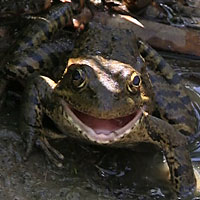 |
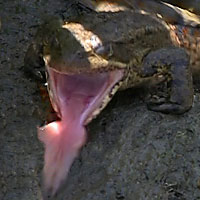 |
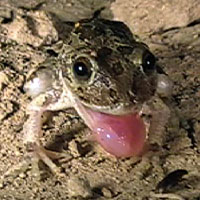 |
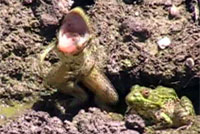 |
||
| In this short video a large adult California Red-legged Frog sits still at the edge of a pond under some vegetation until a grasshopper lands nearby when it explodes into action, grabbing the insect on the underside of its long sticky pink tongue. |
In this short video the same California Red-legged Frog eating grasshoppers, shown in slow motion so you can see its big tongue in action. | In this short video, sitting at night in the Arizona desert next to a breeding pond where other frogs and toads are calling, a Lowland Burrowing Treefrog repeatedly snaps up bugs with its big pink tongue, which you can seen when the action is slowed down a few times. | This short video shows several Chiricahua Leopard Frogs sitting around a pond and jumping after flying insects. The frogs mostly sat and waited for food to come to them, but occasionally they crawled or hopped quickly to catch something. Watch carefully, because they jump so quickly that it's hard to see what is happening. The video is repeated at the end in slow motion so you can see their huge mouths and tongues in action. |
||
 |
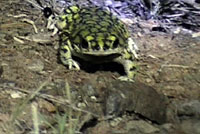 |
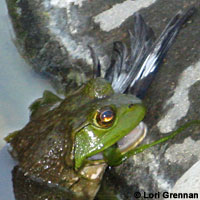 |
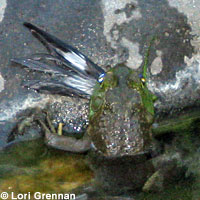 |
||
| This short video made at night shows a Black Toad lunging with its sticky tongue extended, trying to catch something to eat. First in real time, then repeated in slow motion, then we return to real time. | In this short video made at night, a male Sonoran Green Toad stops calling and leaps after a flying insect that is attracted to the video lights. Catching it with his tongue, he backs up and swallows it. This is shown in real time, then repeated in slow motion. | This adult American Bullfrog is eating a lesser goldfinch that came to drink in an artificial pond in Tehama County. © Lori Grennan | |||
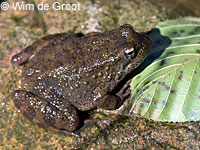 |
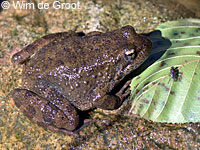 |
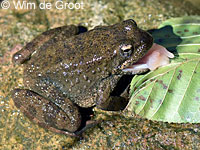 |
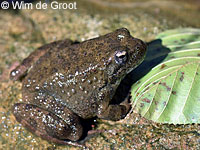 |
||
 |
 |
||||
| Wim de Groot captured this series of four pictures (the bottom two are enlarged versions of the pictures directly above) of a Foothill Yellow-legged Frog eating a fly. We only see part of the tongue that the frog is pulling back into its mouth here. The full tongue was larger when it was fully extended. © Wim de Groot |
|||||
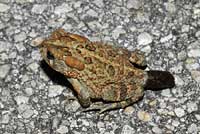 |
 |
 |
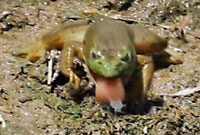 |
||
| A Southern Toad defecating. | In this short video, an American Bullfrog sitting on the edge of a small pond tries to grab an insect with its tongue and fails, but succeeds on the second try, then jumps into the water to finish it off. |
||||
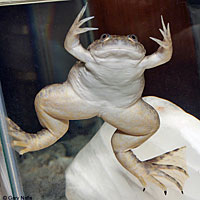 |
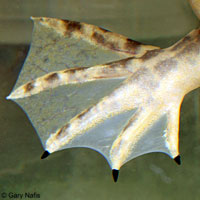 |
 |
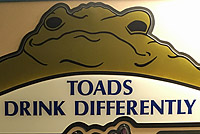 |
||
| Most frogs use a large sticky tongue to grasp food and pull it into the mouth, but the African Clawed Frog has no tongue, being a member of the family Pipidae, the Tongueless Frogs. It is a scavenger, eating live food or dead organic waste that it locates with very sensitive fingers on its hands, an acute sense of smell, and a system of sense organs on the skin which can detect movement and vibrations in the water. It pounces on anything that moves, sucking it in through the mouth, and using its hands and feet to push the food towards its mouth and the claws on its feet to tear apart large chunks of food when necessary. |
This short video shows a Black Toad eating ants with its big pink tongue © Kyla Garten |
||||
 |
 |
||||
| American Bullfrogs are voracious eaters that can impact native species, including threatened species like this Arroyo Toad and this Two-striped Gartersnake, which were found in the belly of a large adult bullfrog in San Diego County. The snake was dead, but the toad was alive. When put back in the creek, it hopped away. A Bullfrog eradication project is now underway at the site where this was photographed. © Andrew Borcher Animals captured and handled under authorization by the California Department of Fish and Wildlife. |
This short video shows the amazing recovery of the Arroyo Toad shown to the left, that was swallowed by an American Bullfrog then cut out of its belly still alive. The toad was revived and released into the creek. © Andrew Borcher Animals captured and handled under authorization by the California Department of Fish and Wildlife. |
||||
| Tadpole Predation | |||||
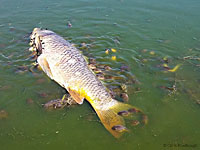 |
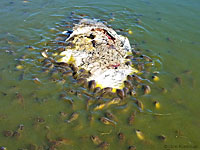 |
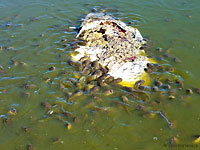 |
 |
||
| Mature American Bullfrog tadpoles eating dead carp in a pond in Washington County, Oregon. © Chris Rombough | |||||
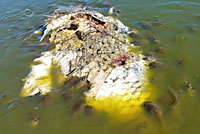 |
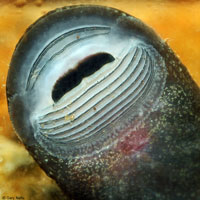 |
 |
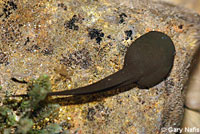 |
||
| Short Video Mature American Bullfrog tadpoles eating dead carp in a pond in Washington County, Oregon. © Chris Rombough |
Most tadpoles have mouths at the front of the head, but the mouth of a Coastal Tailed Frog tadpole is underneath the head, which is flattened. The mouth position and head shape, along with specialized folds that create suction, help a tadpole cling to a rock surface while keeping its body close to the rock. This allows it to scrape food off the surface of underwater rocks in fast-moving creeks without letting the swift current wash it downstream. |
||||
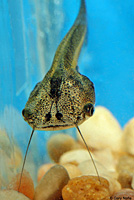 |
 |
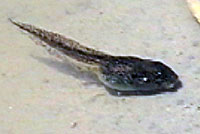 |
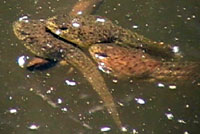 |
||
| The African Clawed Frog tadpole is a filter feeder. It swims with the head down, vibrating its tail rapidly to stir up tiny bits of food such as algae, diatoms, and protozoans. These small food particles are sucked into the mouth and filtered out of the water which is expelled. |
This short video of Sierran Treefrog tadpoles shows how tadpoles move using their long tail, and feed with their mouth on plant material on the surface of the water. | This short video shows some large American Bullfrog tadpoles swimming and feeding. | |||
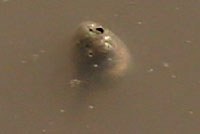 |
|||||
| This short video shows Western Spadefoot tadpoles swimming and feeding in a murky rain puddle. The have to eat as much as possible so they will grow large enough to transform into terrestrial spadefoots before the puddle completely dries up. |
|||||
Predation on Frogs and Toads |
|||||
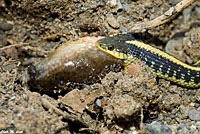 |
 |
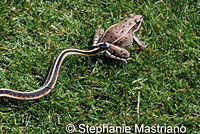 |
 |
||
| Bullfrogs are an invasive species that consume many native species, so it is nice to see this adult Diablo Range Gartersnake eating a Bullfrog tadpole in Santa Clara County. Although eventually the snake regurgitated the tadpole. It was probably too big for it to eat. © Chad Lane | This Valley Gartersnake was found attempting to eat a non-native Leopard Frog in a suburban backyard. (The frog survived, but died later.) © Stephanie Mastriano |
In this short video you can see a tiny recently-metamorphosed spadefoot hopping around the edge of its birth puddle trying to shake off a predatory insect larva (probably a water scavenger beetle larva) which has grasped onto its tail. | |||
 |
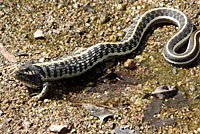 |
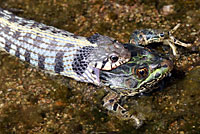 |
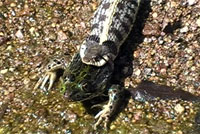 |
||
| A Western Black-necked Gartersnake eating a Chiricahua Leopard Frog. After these pictures were taken, the snake swam across a small pool and finished swallowing the frog, as you can see in the video of this event to the right. |
This short video shows a Western Black-necked Gartersnake swallowing a Chiricahua Leopard Frog, back legs first. The snake swims across the creek to finish eating against the bank, then swims into some roots to hide. The video has been severely edited to keep it short. The entire swallowing activity, after I discoverd the snake with the frog half eaten, took about ten minutes. |
||||
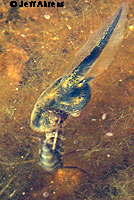 |
 |
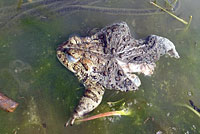 |
 |
||
| Western Spadefoot tadpole preyed upon by some type of aquatic larva, perhaps that of a water beetle or a dragonfly. © Jeff Ahrens |
Toads are conspicuous and at risk during the breeding season when they enter the water and their movement attracts predators. Here next to some freshly-laid toad eggs we see the remnants of a male California Toad which was picked off and eaten by a predator in a Contra Costa pond. | This mature California Tiger Salamander larva is eating a Sierran Treefrog tadpole© Mark Gary | |||
 |
 |
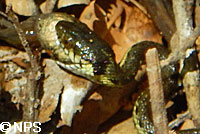 |
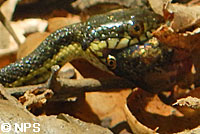 |
||
| This juvenile Two-striped Gartersnake is eating a young California Treefrog (Chorus Frog). © NPS | This juvenile Two-striped Gartersnake is eating a Baja California Treefrog tadpole. © NPS |
||||
 |
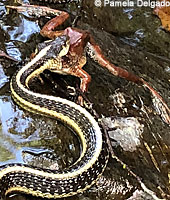 |
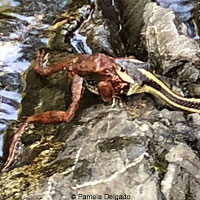 |
|||
| Annie Dillard, in her Pulitzer Prize winning natural history book "Pilgrim at Tinker Creek," describes watching a giant water bug (similar to the water bug shown above) preying on a frog: "At the end of the island I noticed a small green frog. He was exactly half in and half out of the water, looking like a schematic diagram of an amphibian, and he didn't jump.... He was a very small frog with wide, dull eyes. And just as I looked at him, he slowly crumpled and began to sag. The spirit vanished from his eyes as if snuffed. His skin emptied and drooped; his very skull seemed to collapse and settle like a kicked tent. He was shrinking before my eyes like a deflating football. I watched the taut, glistening skin on his shoulders ruck, and rumple, and fall. Soon, part of his skin, formless as a pricked balloon, lay in floating folds like bright scum on top of the water: it was a monstrous and terrifying thing. I gaped bewildered, appalled. An oval shadow hung in the water behind the drained frog; then the shadow glided away. The frog skin bag started to sink." |
An intergrade Aquatic Gartersnake in Napa County eats a frog (either a California Red-legged Frog or a Foothill Yellow-legged Frog.) © Pamela Delgado | ||||
 |
 |
 |
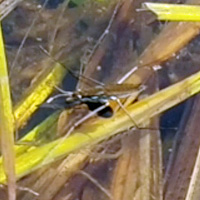 |
||
| Chris Rombough observed water striders (family Gerridae, aka water skippers, pond skaters, and jesus bugs) walking on the surface of the shallow edge of a pond in Deschutes County Oregon. The pond contained clusters of newly-hatched Oregon Spotted Frog, Rana pretiosa, tadpoles, which remained still in clusters on top of the degrading egg masses as frog egg embryos do before they disperse indivitually into the pond as developing tadpoles. In these pictures we see a water strider above the embryos capturing one of them, then two views of the strider as it begins to feed on it. © Chris Rombough |
This short video shows the water strider beginning to eat the embryo then moving away from a rival water strider. © Chris Rombough |
||||
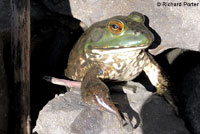 |
 |
 |
|||
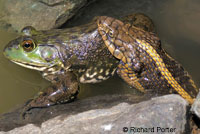 |
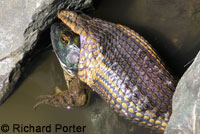 |
 |
|||
| These pictures show an adult Giant Gartersnake eating an adult female American Bullfrog in Sutter County. © Richard Porter | |||||
 |
 |
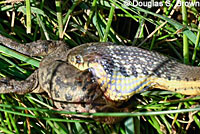 |
|||
| This adult Two-striped Gartersnake was observed eating a California Toad in San Diego County. It took the snake almost 45 minutes to completely swallow the toad, which had puffed its body up to make itself harder to swallow. You can also watch a YouTube video of the event: Two Striped Garter Feeds on a California Toad © Douglas S. Brown |
|||||
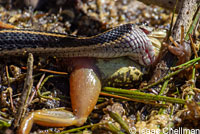 |
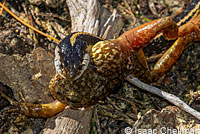 |
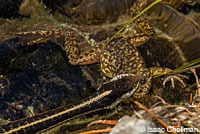 |
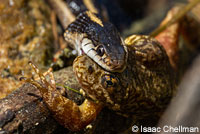 |
||
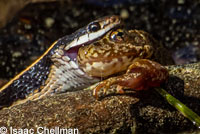 |
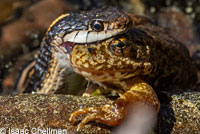 |
 |
|||
| The pictures above show a Mountain Gartersnake discovered by Spencer Williams that is preying on a juvenile Sierra Nevada Yellow-legged Frog in Eldorado County. The last picture shows the frog being swallowed head first. © Isaac Chellman | |||||
 |
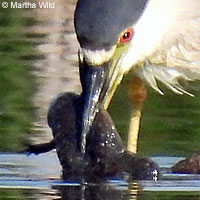 |
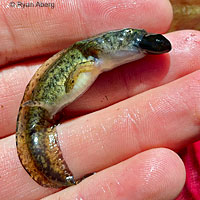 |
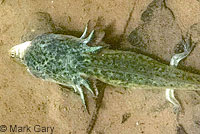 |
||
| Black-Crowned Night Heron eating an African Clawed Frog © Martha Wild |
Mature Southern Long-toed Salamander larva eating a Boreal Toad tadpole, 5,800 ft. Shasta County © Ryan Aberg |
A mature California Tiger Salamander larva eats a Sierran Treefrog tadpole. © Mark Gary |
|||
 |
 |
||||
| Diablo Range Gartersnake eating a Foothill Yellow-legged Frog in Santa Clara County © Zachary Lim | |||||
 |
 |
 |
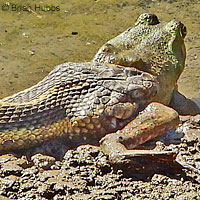 |
||
| This adult California Toad was apparently killed and its less-toxic internal organs eaten by a Shrike, a large songbird that is also sometimes called a "butcher bird" because of its habit of impaling the carcasses of its prey on a thorn, a cactus spine or a barbed wire fence, so it can return later to feed on the leftovers. This one was photographed in Contra Costa County © Mark Gary |
The skin of this California Toad is all that was found in a Contra Costa pond. Whatever ate the toad (maybe a racoon) ate the insides and avoided the poisonous skin. © Mark Gary |
Adult Giant Gartersnake eating an American Bullfrog © Brian Hubbs | |||
Frog Parasites and Deformities |
|||||
| Because of their thin permeable skin, amphibians are one of the first indicators of environmental disturbances, some of which can cause malformations, typically of the limbs. You can read more information about frog deformities and malformations from the Wildlife Futures Program and from Pieter Johnson. |
|||||
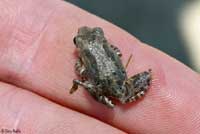 |
 |
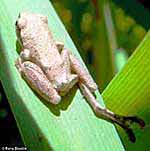 |
|||
| This recently-metamorphosed juvenile Sierran Treefrog from Contra Costa County has a rear leg deformity that is most likely caused by Ribeiroia ondatrae - the frog-mutating flatworm, which is believed to be responsible for many frog limb malformations. The parasite is hosted by a snail before it attaches itself to a tadpole. Such deformities are becoming more common and researchers are trying to determine if there are environmental factors which are favoring the parasites or which make the frogs more susceptible to them. |
This juvenile Sierran Treefrog from San Mateo County has a deformed fifth leg. © Rory Doolin. |
||||
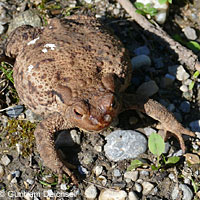 |
 |
 |
|||
| Adult Common Toad - Bufo bufo - infested with eggs and larvae of Lucilia bufonivora - toadfly. Eggs can be seen on the back, and larvae in the nostrils. Heggbach, Fed. state of Baden-Württemberg, Germany. © Guntram Deichsel Wikipedia: The adult toadfly strategically lays its eggs near the nostrils of the common toad, displaying a preference for weakened or injured individuals. Upon hatching, the larvae delicately feed on the nostril tissue, gradually navigating into the intricate passages of the nasal cavities. As they mature, these voracious larvae exhibit an insatiable appetite, devouring not only the host's eyes but also its brain and other vital tissues. |
|||||
Return to the Top
© 2000 -
